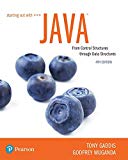
The if statement is an example of a __________.
- a. sequence structure
- b. decision structure
- c. pathway structure
- d. class structure
One of the example of decision structure is “if” statement.
Hence, the correct answer is option “B”.
Explanation of Solution
Decision structure:
Sequence structure cannot handle all types of tasks. These can be achieved using decision structure. Example: “if” statement.
“if” statement:
“if” statement is used to make a decision structure, which permits the program to hold more than one path of execution.
- The indented statement is executed only when the condition is “true”.
- If the given condition is “false”, it skips the indented statements.
Syntax for “if” statement:
if condition:
indented_statement_block
Explanation for incorrect options:
Sequence Structure:
Simplest form of control structure is the “sequence structure”. It is a group of statements that are executed in the order in which they appear.
Hence, the option “A” is wrong.
Pathway Structure:
Pathway structure does not execute the statements under certain conditions.
Hence, the option “C” is wrong.
Class Structure:
Class structure is defined as a hierarchical organization where a community is divided into classes.
Hence, the option “D” is wrong.
Want to see more full solutions like this?
Chapter 3 Solutions
Starting Out with Java: From Control Structures through Data Structures (4th Edition) (What's New in Computer Science)
Additional Engineering Textbook Solutions
Concepts Of Programming Languages
Starting Out with Java: From Control Structures through Objects (7th Edition) (What's New in Computer Science)
Database Concepts (8th Edition)
SURVEY OF OPERATING SYSTEMS
Starting Out with Python (4th Edition)
INTERNATIONAL EDITION---Engineering Mechanics: Statics, 14th edition (SI unit)
 EBK JAVA PROGRAMMINGComputer ScienceISBN:9781337671385Author:FARRELLPublisher:CENGAGE LEARNING - CONSIGNMENT
EBK JAVA PROGRAMMINGComputer ScienceISBN:9781337671385Author:FARRELLPublisher:CENGAGE LEARNING - CONSIGNMENT C++ for Engineers and ScientistsComputer ScienceISBN:9781133187844Author:Bronson, Gary J.Publisher:Course Technology PtrProgramming Logic & Design ComprehensiveComputer ScienceISBN:9781337669405Author:FARRELLPublisher:Cengage
C++ for Engineers and ScientistsComputer ScienceISBN:9781133187844Author:Bronson, Gary J.Publisher:Course Technology PtrProgramming Logic & Design ComprehensiveComputer ScienceISBN:9781337669405Author:FARRELLPublisher:Cengage C++ Programming: From Problem Analysis to Program...Computer ScienceISBN:9781337102087Author:D. S. MalikPublisher:Cengage Learning
C++ Programming: From Problem Analysis to Program...Computer ScienceISBN:9781337102087Author:D. S. MalikPublisher:Cengage Learning EBK JAVA PROGRAMMINGComputer ScienceISBN:9781305480537Author:FARRELLPublisher:CENGAGE LEARNING - CONSIGNMENT
EBK JAVA PROGRAMMINGComputer ScienceISBN:9781305480537Author:FARRELLPublisher:CENGAGE LEARNING - CONSIGNMENT Programming with Microsoft Visual Basic 2017Computer ScienceISBN:9781337102124Author:Diane ZakPublisher:Cengage Learning
Programming with Microsoft Visual Basic 2017Computer ScienceISBN:9781337102124Author:Diane ZakPublisher:Cengage Learning





